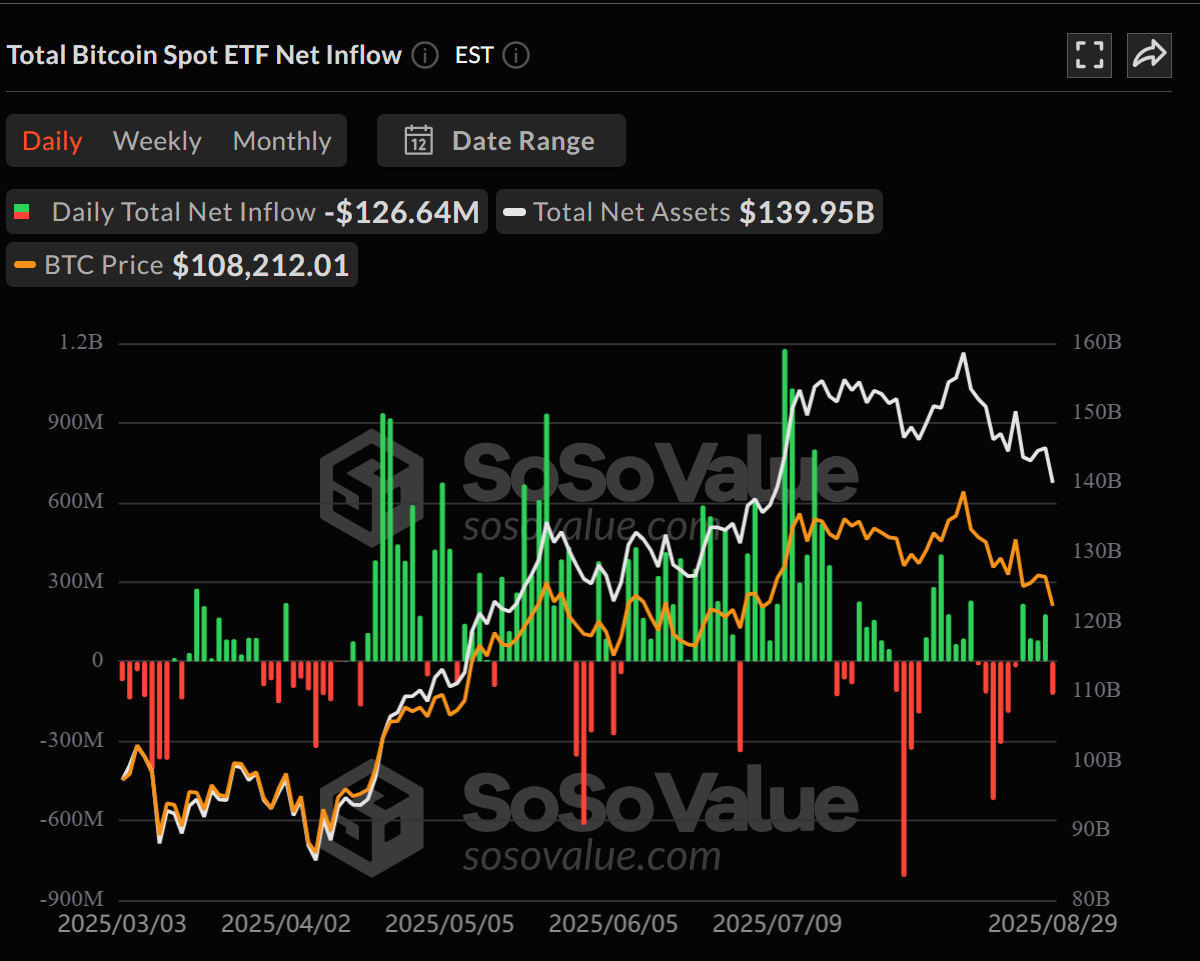Spot Bitcoin and Ether ETF outflows occurred on Friday as funds recorded combined net withdrawals after the Federal Reserve’s hotter-than-expected core PCE reading, with Ether ETFs losing $164.6M and Bitcoin ETFs $126.6M, signaling short-term reallocation amid rising import-driven price pressures.
-
Ether ETFs: -$164.64M in net outflows, reversing five days of inflows
-
Bitcoin ETFs: -$126.64M; total AUM now ~$139.95B for Bitcoin and ~$28.58B for Ethereum
-
Core PCE rose 2.9% annualized in July; tariffs and import costs cited as upward pressure
Meta description: Spot Bitcoin and Ether ETF outflows hit Friday after hotter core PCE data; see fund flows, AUM, driver analysis and expert context — read the full update.
Spot Bitcoin and Ether ETFs recorded notable outflows on Friday after the Federal Reserve reported a hotter core PCE print, with institutional flows reversing recent inflow momentum for Ether and pushing several Bitcoin funds negative.
Spot Bitcoin and Ether ETFs recorded outflows on Friday as the Federal Reserve released key inflation data showing price pressures are creeping higher under President Donald Trump’s trade policies.
According to SoSoValue data, Ether (ETH) ETFs saw a net outflow of $164.64 million, reversing five straight days of inflows that had added more than $1.5 billion to the asset class.
Bitcoin (BTC) ETFs also turned negative with $126.64 million in net outflows, their first daily loss since Aug. 22. Total assets under management dropped to $28.58 billion for Ethereum and $139.95 billion for Bitcoin.

Spot Bitcoin ETFs see outflows on Friday. Source: SoSoValue
What caused Bitcoin and Ether ETF outflows on Friday?
Front-loaded: the immediate trigger was a hotter-than-expected core Personal Consumption Expenditures (PCE) reading from the Federal Reserve, which increased short-term risk aversion. The PCE showed a 2.9% annualized rise in July, prompting some investors to reduce exposure to spot crypto ETFs amid concerns about persistent price pressures.
How did fund-level flows break down?
Fidelity’s FBTC led Bitcoin outflows with $66.2 million withdrawn in a single day. ARK Invest and 21Shares’ ARKB had a $72.07 million net withdrawal, and Grayscale’s GBTC lost $15.3 million. A small number of funds posted inflows, notably BlackRock’s IBIT (+$24.63M) and WisdomTree’s BTCW (+$2.3M).
How did the Fed’s core PCE influence markets?
The core PCE index — the Fed’s preferred inflation gauge — rose 2.9% annualized in July, the highest since February. That result matched expectations but reinforced a narrative that import costs, including tariff-related pressures, are keeping core prices elevated. Market pricing still leaves a chance for a rate cut later, but short-term positioning tightened.
What role did tariffs and import costs play?
Analysts cite the administration’s baseline 10% tariff and additional targeted reciprocal duties as contributors to higher import costs, which in turn lifted some services and goods components of core inflation. Energy moderated headline inflation, yet services rose 3.6% year-over-year, according to public reporting.
Why did Ether ETFs reverse inflows despite long-term demand?
Ether ETFs had accumulated strong inflows since launch, with net AUM gains and a reported 44% rise in investor holdings during August, moving from $9.5 billion to $13.7 billion in inflows-tracking measures. Corporate treasuries are increasingly holding ETH; StrategicETHReserve reports companies now hold roughly 4.4 million ETH (about $19 billion), near 3.7% of total supply.
“After an extended period of underperformance relative to Bitcoin and a souring investor sentiment, Ethereum has recently experienced a significant revival in the recognition of both its adoption rate and value proposition,” Sygnum chief investment officer Fabian Dori told Cointelegraph.
How should investors interpret a single-day ETF outflow?
- Check fund-level flows to see whether outflows are broad-based or concentrated.
- Compare outflows to recent inflow trends—single-day reversals can follow multi-day inflow streaks.
- Monitor macro data (Fed guidance, employment, PCE) for catalysts that could extend the move.
- Assess liquidity and AUM levels to determine whether flows are likely to persist or stabilize.
Frequently Asked Questions
How large were the Bitcoin ETF outflows and which funds were most affected?
Bitcoin ETFs saw $126.64 million in net outflows on Friday. Fidelity’s FBTC had the largest single-day withdrawal among Bitcoin funds (-$66.2M), followed by ARK Invest / 21Shares’ ARKB (-$72.07M combined across products), while GBTC saw -$15.3M.
Will a single day of outflows change long-term ETF adoption?
Single-day outflows do not necessarily alter long-term adoption trends. Longer-term indicators—cumulative inflows, corporate treasury adoption, and regulatory clarity—are better signals of sustained institutional interest.
Key Takeaways
- Immediate driver: Hotter core PCE (2.9% annualized) coincided with ETF outflows.
- Fund flows: Ether ETFs -$164.64M; Bitcoin ETFs -$126.64M; AUM remains substantial for both assets.
- Investor action: Monitor consecutive flow days and macro releases before adjusting strategic exposure.
Conclusion
Spot Bitcoin and Ether ETF outflows on Friday were a direct response to a hotter-than-expected core PCE reading, underscoring the sensitivity of crypto ETF flows to macro shocks. While short-term reallocation occurred, institutional interest indicators such as corporate ETH holdings and cumulative inflows remain important for assessing medium-term trends. Stay updated on fund-level flows and Fed commentary for signs of sustained change.
